Terry Odell's Blog, page 274
August 24, 2011
What's Cooking Wednesday - Sassy Mojo Pork
Thanks to Linda for reminding us about pitching yesterday.Being prepared to promote ourselves at any moment doesn't come easy for a lot of us. Good advice.
And I'm over at Carolyn Schriber's blog, doing a recap of what's happened since I was her guest a year ago.
Now - Happy Anniversary to the Hubster (and me). This is year number 42 for us. And yes, faithful followers of this blog have seen the picture before. I'm in a rut--I post it every year on August 24th.
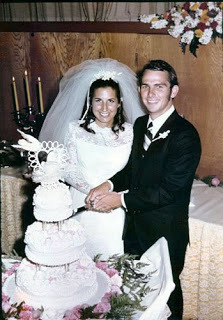
As for What's Cooking Wednesday - I'm going to see how the feature goes, so keep the feedback coming. And feel free to share one of your own recipes.
 Today's recipe is for a grilled pork tenderloin, a favorite dish around our house. Easy to mix up the marinade, and Hubster is generally happy to man the grill.
Today's recipe is for a grilled pork tenderloin, a favorite dish around our house. Easy to mix up the marinade, and Hubster is generally happy to man the grill.
Click for the recipe:
Sassy Mojo Pork
2 ¾ to 1 lb. Pork tenderloins
2 canned chipotle peppers in adobo sauce, rinsed (can be adjusted for your heat preference)
½ c orange juice
¼ c coarsely chopped onion
2 T snipped oregano (or 2 t dried)
2 T lime juice
1 T honey
1 T cooking oil
3 cloves garlic, minced
½ t salt
Combine peppers, orange juice, onion, oregano, lime juice, honey, oil, garlic & salt in blender or food processor. Process or blend until nearly smooth.
Place meat in plastic bag; pour marinade over. Refrigerate 2 hours (not longer).
Drain meat, discard marinade.

Grill to internal temperature of 160, about 20 minutes. Remove from grill, cover with foil and let stand 10 minutes. Garnish with fresh oregano leaves.
Should anyone be inclined to offer anniversary 'gifts' -- I'd love some more followers, especially readers, and some more clicks on the like button on the sidebar, and tweets, etc., below the post. I'm still trying to figure out what the +1 button does, so give it a try and let me know what happened. Come back tomorrow, and I'll have gifts for you.
Like this post? Please share by clicking one of the links below.
And I'm over at Carolyn Schriber's blog, doing a recap of what's happened since I was her guest a year ago.
Now - Happy Anniversary to the Hubster (and me). This is year number 42 for us. And yes, faithful followers of this blog have seen the picture before. I'm in a rut--I post it every year on August 24th.

As for What's Cooking Wednesday - I'm going to see how the feature goes, so keep the feedback coming. And feel free to share one of your own recipes.
 Today's recipe is for a grilled pork tenderloin, a favorite dish around our house. Easy to mix up the marinade, and Hubster is generally happy to man the grill.
Today's recipe is for a grilled pork tenderloin, a favorite dish around our house. Easy to mix up the marinade, and Hubster is generally happy to man the grill. Click for the recipe:
Sassy Mojo Pork
2 ¾ to 1 lb. Pork tenderloins
2 canned chipotle peppers in adobo sauce, rinsed (can be adjusted for your heat preference)
½ c orange juice
¼ c coarsely chopped onion
2 T snipped oregano (or 2 t dried)
2 T lime juice
1 T honey
1 T cooking oil
3 cloves garlic, minced
½ t salt
Combine peppers, orange juice, onion, oregano, lime juice, honey, oil, garlic & salt in blender or food processor. Process or blend until nearly smooth.
Place meat in plastic bag; pour marinade over. Refrigerate 2 hours (not longer).
Drain meat, discard marinade.

Grill to internal temperature of 160, about 20 minutes. Remove from grill, cover with foil and let stand 10 minutes. Garnish with fresh oregano leaves.
Should anyone be inclined to offer anniversary 'gifts' -- I'd love some more followers, especially readers, and some more clicks on the like button on the sidebar, and tweets, etc., below the post. I'm still trying to figure out what the +1 button does, so give it a try and let me know what happened. Come back tomorrow, and I'll have gifts for you.
Like this post? Please share by clicking one of the links below.
Published on August 24, 2011 04:00
August 23, 2011
Who Has to Pitch?
Today I welcome Linda Rohrbough to Terry's Place. Linda has been writing since 1989, and has more than 5,000 articles and seven books to her credit along with national awards for fiction and non-fiction.
I've seen new authors look a little shocked when they figure out they're going to be pitching their books the entire remainder of their career. Most everyone thinks (and I did, too) that once you get an agent, your pitching days are over. Au contraire. But writers aren't the only ones who have to pitch.
First, let's define terms here. When I say pitch in terms of a writer, what I mean is a short dialog about a book that piques the interest of the listener. This is most commonly known as the "elevator pitch."
Some of the elements of a good pitch is it has an easy, effortless quality for the listener – meaning it's clean and without verbal clutter. It should be packed with emotional hooks that engage the listener. And at the end it should be tied up with a neat concept that's memorable and universal. All this has to be done in a few sentences, I suggest three, so it's easily deliverable in an elevator at a length of 1 to 2 minutes or less.
Now, the reason writers never stop doing this is because if they succeed, they are going to be eternally faced with talking about their work in an effective way to people they don't know: book store owners, librarians, people in readers groups, potential fans at book signings, and even people they meet while shopping.
How do I know the latter, you ask? Ah, because I have traveled with my New York Times best-selling writer friends. And I've watched them effectively pitch their books to waitresses, store clerks, and even street vendors. And almost every time, they come away with a new fan.
Sound like a tall order? It's not that hard, once you know how, which is of course, where I come in. But rather than going into a commercial about what I offer writers, let me get back to the subject of this blog. Which is: are writers the only ones who have to learn to pitch for their entire careers?
I've discovered there's a surprising array of people who have to learn to effectively talk about their work to people they don't know. Which is usually an entirely different skill-set that actually doing the work.
Some of these people include artists, vice-Presidents in large firms and even housekeepers.
Let's take artists, for example. They face many of the same obstacles that writers do. In the art world, it's gallery owners and collectors that act as the gateway to successful sales. If there are twenty-five talented artists competing for a spot, you can bet the one who talks effectively about their work, both verbally and on paper, will be the one they'll pick.
Or a vice president steps into the elevator at work with the new boss. And the boss turns and says, "So tell me about what you do?"
Even a housekeeper trying to get work needs a pitch. What sets them apart from the other fifteen services handing out business cards in the neighborhood?
It seems to me that the people who get the breaks are the ones who can communicate in a clean, effective, and succinct way, what they do. In other words, the ones who can pitch. What do you think? Do you need an effective pitch for your work? What professions to you know of that need a pitch?
Linda Rohrbough has been writing since 1989, and has more than 5,000 articles and seven books to her credit along with national awards for fiction and non-fiction. She also has an iPhone app of her popular "Pitch Your Book" workshop available on Apple's iTunes store. Visit her website: www.LindaRohrbough.com
Like this post? Please share by clicking one of the links below.
I've seen new authors look a little shocked when they figure out they're going to be pitching their books the entire remainder of their career. Most everyone thinks (and I did, too) that once you get an agent, your pitching days are over. Au contraire. But writers aren't the only ones who have to pitch.
First, let's define terms here. When I say pitch in terms of a writer, what I mean is a short dialog about a book that piques the interest of the listener. This is most commonly known as the "elevator pitch."
Some of the elements of a good pitch is it has an easy, effortless quality for the listener – meaning it's clean and without verbal clutter. It should be packed with emotional hooks that engage the listener. And at the end it should be tied up with a neat concept that's memorable and universal. All this has to be done in a few sentences, I suggest three, so it's easily deliverable in an elevator at a length of 1 to 2 minutes or less.
Now, the reason writers never stop doing this is because if they succeed, they are going to be eternally faced with talking about their work in an effective way to people they don't know: book store owners, librarians, people in readers groups, potential fans at book signings, and even people they meet while shopping.
How do I know the latter, you ask? Ah, because I have traveled with my New York Times best-selling writer friends. And I've watched them effectively pitch their books to waitresses, store clerks, and even street vendors. And almost every time, they come away with a new fan.
Sound like a tall order? It's not that hard, once you know how, which is of course, where I come in. But rather than going into a commercial about what I offer writers, let me get back to the subject of this blog. Which is: are writers the only ones who have to learn to pitch for their entire careers?
I've discovered there's a surprising array of people who have to learn to effectively talk about their work to people they don't know. Which is usually an entirely different skill-set that actually doing the work.
Some of these people include artists, vice-Presidents in large firms and even housekeepers.
Let's take artists, for example. They face many of the same obstacles that writers do. In the art world, it's gallery owners and collectors that act as the gateway to successful sales. If there are twenty-five talented artists competing for a spot, you can bet the one who talks effectively about their work, both verbally and on paper, will be the one they'll pick.
Or a vice president steps into the elevator at work with the new boss. And the boss turns and says, "So tell me about what you do?"
Even a housekeeper trying to get work needs a pitch. What sets them apart from the other fifteen services handing out business cards in the neighborhood?
It seems to me that the people who get the breaks are the ones who can communicate in a clean, effective, and succinct way, what they do. In other words, the ones who can pitch. What do you think? Do you need an effective pitch for your work? What professions to you know of that need a pitch?
Linda Rohrbough has been writing since 1989, and has more than 5,000 articles and seven books to her credit along with national awards for fiction and non-fiction. She also has an iPhone app of her popular "Pitch Your Book" workshop available on Apple's iTunes store. Visit her website: www.LindaRohrbough.com
Like this post? Please share by clicking one of the links below.
Published on August 23, 2011 05:00
August 22, 2011
The Nose Knows
What I'm reading: Breaking Loose by Tara Janzen.
What's in a Name? is the Frugal Find of the Day. Please check it out (and send friends that way!)
On Saturday, I went to a small writing seminar, focused on writing crime/mystery stories. One of the presenters was a bloodhound handler, and I found her talk fascinating. Through her talk, I discovered that despite my research for a scene in Finding Sarah, I didn't know the right questions to research, so I have an error in that scene. Once the rights revert to me, you can be sure I'm going to fix it!

(And no, I'm not going to tell you what the mistake was. If you've read the book, then you can check for yourself.)
Our speaker was Ingela Tapper, and she provided a most entertaining session. Highlights of the session:
The bloodhound breed goes back to the 7th century. They are "man trackers" and work on recognizing and finding a specific scent.
They can be cross trained to find live victims/suspects, as well as cadavers.
Almost all the training involves teaching the human to learn to read the dog. The dogs know what they're doing and should be trusted to do their jobs. They become single-minded about finding their target, and their handler has to be in excellent physical shape to keep up. Ingela is a very slight woman, and she mentioned going airborne behind her dogs, which often outweighed her by more than 25 pounds.
Bloodhound anatomy is designed for tracking. Their ears and facial skin folds trap the scent in a kind of "scent bank". Also, their large paws will stir up the scent for trails more than 24 hours old.
These dogs are also prolific at saliva production. This moistens the scent and helps them find scent trails over 36 – 48 hours old.
Much of Ingela's work involves finding missing children, and she says in about 75% of the cases, there's a criminal element involved. Usually the abductors are people known to the family. But she's also helped track and find murderers and criminals such as bank robbers.
The best scent items are items containing bodily fluids of the missing person. She says the best item for tracking a missing young child is a dirty diaper, but any used underwear or socks also make excellent scent items for the dog.
She gave an example of having to work on a murder case where the body was found six months after death. The victim was badly decomposed, but the murder weapon, an axe, was near the body. In this case, there's no need to find the victim; it's already there. But the axe handle likely has scent traces of the killer. Using tongs to avoid any cross-contamination, she applies a piece of gauze to the handle of the axe, and then places it in a plastic bag. She lets the dog sniff the bag, and then it's turned over as evidence. That's all the dog needs – one sniff, and it takes off in search of its target. (For parents concerned that someday you might need your child--or elderly parent--found, here's a tip):
Have the person exhale into a plastic ziplock bag and put it in the freezer. The scent will be all the dog needs. (Or, you can freeze a dirty diaper, but that might not be as appealing--especially if you're putting it next to that layer of wedding cake you've frozen for your anniversary)
She told us that her dog once found a body buried at some depth under a concrete pad. Although the deputies told her it wasn't possible that the body was there, the dog refused to leave, and she convinced the deputies that the dog knew more than any of the humans.
Handlers keep logs of every case and every training session. As long as the bloodhound is purebred with a pedigree on record, the courts will accept the evidence the handler presents. Other breeds need to have certification of training, but it's accepted that a bloodhound knows its job.
If the criminal is long gone (and Ingela tries very hard to convince the law enforcement officers to bring in the dogs immediately because it makes their job easier), the dogs can still determine direction of travel, and she stated one case where the dog led her to a bus depot (even though it had been several months since the crime had been committed). They called in all the buses leaving from that depot on or about the date and time of the crime, and the dog found evidence on the seat of one of the buses. They were able, using the cameras on the buses, to determine his identity.
Bloodhounds are friendly. They'll find their target, but they're not attack dogs. Dog handlers will have police backup and it's the police who do the apprehending.
Alzheimer's patients are difficult to find because a person's scent is intensified by adrenaline, which is released when a person feels fear or aggression. However, these patients normally are unaware they're lost and aren't afraid. Ingela spoke of finding an 80 year old woman Alzheimer's patient who had "wandered" over 8 miles from her nursing home, walking down a freeway and ending up on the top of a very steep hill.
Some misconceptions (including the one I have to fix in Finding Sarah):
If the target is in a car, the dog won't be able to find him. Cars aren't airtight, and there's still a scent trail to follow.
Running into water will throw the dogs off the scent. In fact, water intensifies the scent, and Ingela is thrilled when a target runs into a creek. The dog has no trouble finding him (although Ingela's not always so happy about having to run through the water. She has her dogs on a 30 foot lead, but often that doesn't allow her to run along the bank.) She told us about her dog diving off a dock in San Francisco to find a man who'd fallen into the water. He'd been trapped at the bottom and had drowned, but that didn't seem to bother the dog. He found his target, although it took some "convincing" of the humans who couldn't see anything in the murky water.
Bloodhounds don't bark and bay as they track. Occasionally, one might make noise after the target is found, but they're silent trackers.
Tomorrow, my guest is Linda Rohrbough, and she's talking about pitching. She has some great pointers, so come back!
Like this post? Please share by clicking one of the links below.
What's in a Name? is the Frugal Find of the Day. Please check it out (and send friends that way!)
On Saturday, I went to a small writing seminar, focused on writing crime/mystery stories. One of the presenters was a bloodhound handler, and I found her talk fascinating. Through her talk, I discovered that despite my research for a scene in Finding Sarah, I didn't know the right questions to research, so I have an error in that scene. Once the rights revert to me, you can be sure I'm going to fix it!

(And no, I'm not going to tell you what the mistake was. If you've read the book, then you can check for yourself.)
Our speaker was Ingela Tapper, and she provided a most entertaining session. Highlights of the session:
The bloodhound breed goes back to the 7th century. They are "man trackers" and work on recognizing and finding a specific scent.
They can be cross trained to find live victims/suspects, as well as cadavers.
Almost all the training involves teaching the human to learn to read the dog. The dogs know what they're doing and should be trusted to do their jobs. They become single-minded about finding their target, and their handler has to be in excellent physical shape to keep up. Ingela is a very slight woman, and she mentioned going airborne behind her dogs, which often outweighed her by more than 25 pounds.
Bloodhound anatomy is designed for tracking. Their ears and facial skin folds trap the scent in a kind of "scent bank". Also, their large paws will stir up the scent for trails more than 24 hours old.
These dogs are also prolific at saliva production. This moistens the scent and helps them find scent trails over 36 – 48 hours old.
Much of Ingela's work involves finding missing children, and she says in about 75% of the cases, there's a criminal element involved. Usually the abductors are people known to the family. But she's also helped track and find murderers and criminals such as bank robbers.
The best scent items are items containing bodily fluids of the missing person. She says the best item for tracking a missing young child is a dirty diaper, but any used underwear or socks also make excellent scent items for the dog.
She gave an example of having to work on a murder case where the body was found six months after death. The victim was badly decomposed, but the murder weapon, an axe, was near the body. In this case, there's no need to find the victim; it's already there. But the axe handle likely has scent traces of the killer. Using tongs to avoid any cross-contamination, she applies a piece of gauze to the handle of the axe, and then places it in a plastic bag. She lets the dog sniff the bag, and then it's turned over as evidence. That's all the dog needs – one sniff, and it takes off in search of its target. (For parents concerned that someday you might need your child--or elderly parent--found, here's a tip):
Have the person exhale into a plastic ziplock bag and put it in the freezer. The scent will be all the dog needs. (Or, you can freeze a dirty diaper, but that might not be as appealing--especially if you're putting it next to that layer of wedding cake you've frozen for your anniversary)
She told us that her dog once found a body buried at some depth under a concrete pad. Although the deputies told her it wasn't possible that the body was there, the dog refused to leave, and she convinced the deputies that the dog knew more than any of the humans.
Handlers keep logs of every case and every training session. As long as the bloodhound is purebred with a pedigree on record, the courts will accept the evidence the handler presents. Other breeds need to have certification of training, but it's accepted that a bloodhound knows its job.
If the criminal is long gone (and Ingela tries very hard to convince the law enforcement officers to bring in the dogs immediately because it makes their job easier), the dogs can still determine direction of travel, and she stated one case where the dog led her to a bus depot (even though it had been several months since the crime had been committed). They called in all the buses leaving from that depot on or about the date and time of the crime, and the dog found evidence on the seat of one of the buses. They were able, using the cameras on the buses, to determine his identity.
Bloodhounds are friendly. They'll find their target, but they're not attack dogs. Dog handlers will have police backup and it's the police who do the apprehending.
Alzheimer's patients are difficult to find because a person's scent is intensified by adrenaline, which is released when a person feels fear or aggression. However, these patients normally are unaware they're lost and aren't afraid. Ingela spoke of finding an 80 year old woman Alzheimer's patient who had "wandered" over 8 miles from her nursing home, walking down a freeway and ending up on the top of a very steep hill.
Some misconceptions (including the one I have to fix in Finding Sarah):
If the target is in a car, the dog won't be able to find him. Cars aren't airtight, and there's still a scent trail to follow.
Running into water will throw the dogs off the scent. In fact, water intensifies the scent, and Ingela is thrilled when a target runs into a creek. The dog has no trouble finding him (although Ingela's not always so happy about having to run through the water. She has her dogs on a 30 foot lead, but often that doesn't allow her to run along the bank.) She told us about her dog diving off a dock in San Francisco to find a man who'd fallen into the water. He'd been trapped at the bottom and had drowned, but that didn't seem to bother the dog. He found his target, although it took some "convincing" of the humans who couldn't see anything in the murky water.
Bloodhounds don't bark and bay as they track. Occasionally, one might make noise after the target is found, but they're silent trackers.
Tomorrow, my guest is Linda Rohrbough, and she's talking about pitching. She has some great pointers, so come back!
Like this post? Please share by clicking one of the links below.
Published on August 22, 2011 04:00
August 19, 2011
Friday Field Trip - Cripple Creek and Victor
While I was at RomCon, Hubster went out and about. These pictures are some he took on his sojourn to the Cripple Creek/Victor area.

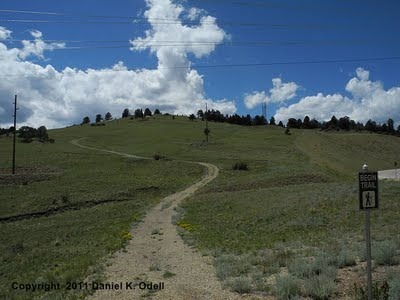
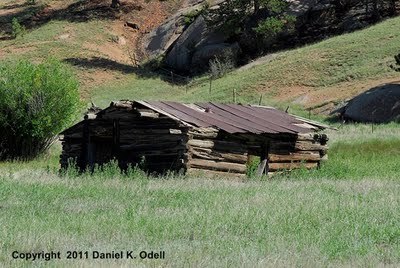




Like this post? Please share by clicking one of the links below.







Like this post? Please share by clicking one of the links below.
Published on August 19, 2011 04:00
August 18, 2011
Reader Reviews - Yes or No?
What I'm reading: Shadows of Yesterday, by Sandra Brown
I hope you enjoyed yesterday's recipe. I'd love some honest feedback as to whether you think having a "foodie day" here would add to the blog. I'd be delighted to share favorite recipes from my readers. Or would you simply skip Wednesdays? If you'd like me to continue, please let me know in the comments, or click the +1 button. Feedback really helps.
 One of the loops I'm on had an interesting discussion of reviews: Did we give them, did we like them, did they do anything for sales. Now, my publisher that targets the library market wants reviews, and they definitely drive library sales. My Publishers Weekly review for WHERE DANGER HIDES has placed it in more than twice the libraries, many of them ordering multiple copies, than my non-reviewed WHEN DANGER CALLS. But what about "non-professional reviews"? I'm talking about reviews from readers, and not those posted on dedicated review sites.
One of the loops I'm on had an interesting discussion of reviews: Did we give them, did we like them, did they do anything for sales. Now, my publisher that targets the library market wants reviews, and they definitely drive library sales. My Publishers Weekly review for WHERE DANGER HIDES has placed it in more than twice the libraries, many of them ordering multiple copies, than my non-reviewed WHEN DANGER CALLS. But what about "non-professional reviews"? I'm talking about reviews from readers, and not those posted on dedicated review sites.
If you've noticed, I don't do reviews here. I'll post whatever I might be reading, but I don't offer my opinion. And if a book triggers a discussion topic, I don't usually mention it by name. Why?
Like everything else, it's complicated.
First, as an author, I don't read the same way I did before I started writing. I'm afraid I'd be too critical. And who wants to get less-than-glowing reviews? Some folks I know say they won't post a review if it's under 4 stars because they know nobody wants a poor review. And there's the underlying fear (ego-driven or not) that anyone who disagrees with my take on a book will either reciprocate in kind or not want to buy my books.
Then there's the time factor. If it's established that I can't review every book someone wants me to read, then if they don't get a review from me, do they think I didn't like the book. And that can lead back to that reciprocity thing above.
But, at least on Amazon, it appears that the more reviews, the better the sales. Some members of the discussion group said they have a second persona that they use for reviews. Others say they think leaving reviews in their own names will drive people to their own books. (See that reciprocity thing above again for the flip side to this one.)
And what about the readers who will give low marks for things totally unrelated to the book at all? Didn't like the cover. Formatting issues. Haven't finished the book yet, but didn't like a character's name in chapter five? Or they post a "book report" and give away the salient plot points?
Someone at the discussion board suggested that readers use the Netflix system, in which you rate a movie and Netflix then suggests others you'd like based on your rating.
Someone else took the comparison a step further. What if you went to an art museum and there were buttons to push under each picture, where you could give it a rating of from 1-5 stars? Are visitors to a museum qualified to 'review' art? Does it matter? They know what they like, right? But would it change perception of "good" if, let's say, the Mona Lisa got an overall 3 star rating?
What's your take? Authors and readers both, please. And, whether or not I agree with the system or think it works, if you'd like to review Danger in Deer Ridge or What's in a Name? let me know and I'll give you a download in exchange.
Tomorrow, Hubster's in charge of the Friday Field Trip. When I was at RomCon, he was out and about.
Like this post? Please share by clicking one of the links below.
I hope you enjoyed yesterday's recipe. I'd love some honest feedback as to whether you think having a "foodie day" here would add to the blog. I'd be delighted to share favorite recipes from my readers. Or would you simply skip Wednesdays? If you'd like me to continue, please let me know in the comments, or click the +1 button. Feedback really helps.
 One of the loops I'm on had an interesting discussion of reviews: Did we give them, did we like them, did they do anything for sales. Now, my publisher that targets the library market wants reviews, and they definitely drive library sales. My Publishers Weekly review for WHERE DANGER HIDES has placed it in more than twice the libraries, many of them ordering multiple copies, than my non-reviewed WHEN DANGER CALLS. But what about "non-professional reviews"? I'm talking about reviews from readers, and not those posted on dedicated review sites.
One of the loops I'm on had an interesting discussion of reviews: Did we give them, did we like them, did they do anything for sales. Now, my publisher that targets the library market wants reviews, and they definitely drive library sales. My Publishers Weekly review for WHERE DANGER HIDES has placed it in more than twice the libraries, many of them ordering multiple copies, than my non-reviewed WHEN DANGER CALLS. But what about "non-professional reviews"? I'm talking about reviews from readers, and not those posted on dedicated review sites.If you've noticed, I don't do reviews here. I'll post whatever I might be reading, but I don't offer my opinion. And if a book triggers a discussion topic, I don't usually mention it by name. Why?
Like everything else, it's complicated.
First, as an author, I don't read the same way I did before I started writing. I'm afraid I'd be too critical. And who wants to get less-than-glowing reviews? Some folks I know say they won't post a review if it's under 4 stars because they know nobody wants a poor review. And there's the underlying fear (ego-driven or not) that anyone who disagrees with my take on a book will either reciprocate in kind or not want to buy my books.
Then there's the time factor. If it's established that I can't review every book someone wants me to read, then if they don't get a review from me, do they think I didn't like the book. And that can lead back to that reciprocity thing above.
But, at least on Amazon, it appears that the more reviews, the better the sales. Some members of the discussion group said they have a second persona that they use for reviews. Others say they think leaving reviews in their own names will drive people to their own books. (See that reciprocity thing above again for the flip side to this one.)
And what about the readers who will give low marks for things totally unrelated to the book at all? Didn't like the cover. Formatting issues. Haven't finished the book yet, but didn't like a character's name in chapter five? Or they post a "book report" and give away the salient plot points?
Someone at the discussion board suggested that readers use the Netflix system, in which you rate a movie and Netflix then suggests others you'd like based on your rating.
Someone else took the comparison a step further. What if you went to an art museum and there were buttons to push under each picture, where you could give it a rating of from 1-5 stars? Are visitors to a museum qualified to 'review' art? Does it matter? They know what they like, right? But would it change perception of "good" if, let's say, the Mona Lisa got an overall 3 star rating?
What's your take? Authors and readers both, please. And, whether or not I agree with the system or think it works, if you'd like to review Danger in Deer Ridge or What's in a Name? let me know and I'll give you a download in exchange.
Tomorrow, Hubster's in charge of the Friday Field Trip. When I was at RomCon, he was out and about.
Like this post? Please share by clicking one of the links below.
Published on August 18, 2011 04:00
August 17, 2011
What's Coooking Wednesday? Almond Torte
What I'm reading: Breaking Silence, by Linda Castillo
Thanks to DeAnna for yesterday's post. Thought provoking and informative.
After Monday's post about marketing, I thought I'd follow up with a bit more discussion.
 There are all sorts of opinions on what works where. Do people care if you tweet (or Google+ or Facebook--not sure what the right verbs are for those) about the mundane? Although most say they don't care, for some reason, I get the most feedback to my Facebook posts when I share pictures of food. I posted a picture of the cake I made for our community picnic last weekend, and had a LOT more action over there than when I talk about writing.
There are all sorts of opinions on what works where. Do people care if you tweet (or Google+ or Facebook--not sure what the right verbs are for those) about the mundane? Although most say they don't care, for some reason, I get the most feedback to my Facebook posts when I share pictures of food. I posted a picture of the cake I made for our community picnic last weekend, and had a LOT more action over there than when I talk about writing.
So -- why not share it here? And if people are interested, maybe I'll continue this "What's Cooking Wednesday" as a regular feature. And I'd love some reader guests -- my Tuesdays aren't restricted to writers, although that seems to be where they come from. But the topic isn't restricted to writing. Travel and hobbies are also popular topics.
OK -- here's this week's recipe: Almond Torte.
Glazed Almond Torte (with Strawberries)
1 cup blanched almonds, 5 oz
3/4 cup sugar
4 eggs
 2/3 cup macaroon cookie crumbs (Mom uses Amaretti cookies, but plain macaroon cookies are fine – The crisp ones, not the chewy kind.)
2/3 cup macaroon cookie crumbs (Mom uses Amaretti cookies, but plain macaroon cookies are fine – The crisp ones, not the chewy kind.)
1/4 cup butter, softened, 1/2 stick
1 t. baking powder
1 t. vanilla
1/2 t. almond extract
In food processor, process almonds and sugar until almonds are pulverized. Add remaining ingredients and process mixture for 30 seconds. Pour batter into a buttered 10 inch springform pan and bake at 350 for 35 minutes or until top is golden and a cake tester inserted in center comes out clean.
Allow torte to cool in pan. Make the glaze:
Grand Marnier Glaze:
3/4 cup red currant jelly
1 T. Grand Marnier Liqueur (Triple Sec is okay, too)
In a pan, heat currant jelly until melted. Stir in Grand Marnier until blended. Spread glaze over the cooled cake
To fancy it up, you can add:
1 pint fresh strawberries, hulled and sliced
Fresh strawberries, hulled and left whole
Dip whole strawberries in glaze and set aside. Add sliced strawberries to the glaze and mix until nicely coated, then put on top of the torte. Decorate with whole glazed strawberries. To serve, cut into wedges. A dollop of whipped cream is a nice addition, but not a must. Serves 8 to 10
Note: If you do not own a food processor, almonds must be ground with a nut grater. Batter must then be beaten for 4 minutes at high speed.
Like this post? Please share by clicking one of the links below.
Thanks to DeAnna for yesterday's post. Thought provoking and informative.
After Monday's post about marketing, I thought I'd follow up with a bit more discussion.
 There are all sorts of opinions on what works where. Do people care if you tweet (or Google+ or Facebook--not sure what the right verbs are for those) about the mundane? Although most say they don't care, for some reason, I get the most feedback to my Facebook posts when I share pictures of food. I posted a picture of the cake I made for our community picnic last weekend, and had a LOT more action over there than when I talk about writing.
There are all sorts of opinions on what works where. Do people care if you tweet (or Google+ or Facebook--not sure what the right verbs are for those) about the mundane? Although most say they don't care, for some reason, I get the most feedback to my Facebook posts when I share pictures of food. I posted a picture of the cake I made for our community picnic last weekend, and had a LOT more action over there than when I talk about writing.So -- why not share it here? And if people are interested, maybe I'll continue this "What's Cooking Wednesday" as a regular feature. And I'd love some reader guests -- my Tuesdays aren't restricted to writers, although that seems to be where they come from. But the topic isn't restricted to writing. Travel and hobbies are also popular topics.
OK -- here's this week's recipe: Almond Torte.
Glazed Almond Torte (with Strawberries)
1 cup blanched almonds, 5 oz
3/4 cup sugar
4 eggs
 2/3 cup macaroon cookie crumbs (Mom uses Amaretti cookies, but plain macaroon cookies are fine – The crisp ones, not the chewy kind.)
2/3 cup macaroon cookie crumbs (Mom uses Amaretti cookies, but plain macaroon cookies are fine – The crisp ones, not the chewy kind.)1/4 cup butter, softened, 1/2 stick
1 t. baking powder
1 t. vanilla
1/2 t. almond extract
In food processor, process almonds and sugar until almonds are pulverized. Add remaining ingredients and process mixture for 30 seconds. Pour batter into a buttered 10 inch springform pan and bake at 350 for 35 minutes or until top is golden and a cake tester inserted in center comes out clean.
Allow torte to cool in pan. Make the glaze:
Grand Marnier Glaze:
3/4 cup red currant jelly
1 T. Grand Marnier Liqueur (Triple Sec is okay, too)
In a pan, heat currant jelly until melted. Stir in Grand Marnier until blended. Spread glaze over the cooled cake
To fancy it up, you can add:
1 pint fresh strawberries, hulled and sliced
Fresh strawberries, hulled and left whole
Dip whole strawberries in glaze and set aside. Add sliced strawberries to the glaze and mix until nicely coated, then put on top of the torte. Decorate with whole glazed strawberries. To serve, cut into wedges. A dollop of whipped cream is a nice addition, but not a must. Serves 8 to 10
Note: If you do not own a food processor, almonds must be ground with a nut grater. Batter must then be beaten for 4 minutes at high speed.
Like this post? Please share by clicking one of the links below.
Published on August 17, 2011 04:00
August 16, 2011
Getting Your Hands Dirty as a Professional Writer
Today my guest is author DeAnna Knippling, who's got some excellent advice about becoming a professional writer. And while DeAnna is holding down the fort
at Terry's Place, I'm doing my monthly post at The Blood Red Pencil. Welcome, DeAnna.
The publishing world is full of the controversy between independent and traditional publishing, but the real secret is that professional writers need to take control of their writing business, no matter which side of the coin they're on (or both).
When did business get to be a dirty word, when it came to writing?
Probably back in prehistoric times, when one Neanderthal looked at another and said, "You know, that story was pretty good. What you need is a wider audience. I can get you that...for 87.5% of your total meat and flint intake, less 15%. But don't worry. You'll probably make more money with me than you could on your own. I mean, you do want to spend all your time telling stories, right?"
As far as I can tell, most writers, most of the time, will opt to let someone else take care of the business for them, especially after a lengthy explanation of why they really shouldn't do it themselves. (If you can figure out what day of the week it is and guesstimate a tip at a restaurant, you have all the basic talent at math you really need.) It's true that learning how to write is an intense, time-consuming process and that you have to budget your time to focus on writing. But putting your financial future in someone else's hands is almost never a good idea...unless you never plan to make money or get published.
But, short of going to college for an MBA in running your writing business, what do you do?
Learning how to be a professional writer who doesn't have to have your hand held at every turn takes time...but not as much time as it takes to get an MBA (or even a business minor). Here are some basic, broad steps that I've taken so far. I'm not going to claim to be an expert, but I've seen professional writers recommend these steps over and over, too:
1) Set up a business, with a business bank account. Plenty of people set up businesses daily, and the process is fairly streamlined; if you go online to your state Department of Revenue, you'll find most of what you need. Going to the IRS.gov website will help you with most of the rest. The publisher Nolo has good books on setting up a small business; you'll want to read a few of them and take their good advice.
2) Set up an online presence, including a hosting service, blog, and social media accounts. Writers don't need to set up store fronts and hire employees to run them--so consider yourself lucky!
3) Learn how copyright works. Nolo has an excellent book, The Copyright Handbook , at their website.
4) Learn how contracts and agency work. Again, head over to Nolo. Publishing contracts are, as far as I've heard, different than most contracts, but that's mostly because writers put up with more than they should. I also recommend www.ThePassiveVoice.com, which is a former lawyer posting on issues specific to writers.
5) Join the writing community and listen to a wide range of opinions. Because writers have been buying into the idea that traditional publishing using an agent is the only option other than vanity publishing for a long time, I recommend taking the time to read information from people who question that, with various results. Check out J.A. Konrath, Michael Stackpole, Dean Wesley Smith, Kristine Kathryn Rusch, Laura Resnick, Amanda Hocking, Barry Eisler, and more.
6) Get your hands dirty by learning the self-publishing business on a few short stories. The more you know about the process of publishing, the better--and learning how to edit, format, and find (legal) cover images and fonts for your stories will make you more knowledgeable as a writer in traditional publishing, too. Learning how to market your stories is also a good thing...and you'll have something to compare traditional publishing to. I'd start at Smashwords; they have great instructions on how to get started.
The learning curve for being a professional writer instead of a hobbyist is pretty curvy--but not as steep as signing a bad contract.
We seem to have the attitude that all business is dirty business, and that the more ignorant we are of how money and contracts work, the better we will be as writers. (If nothing else, it's good research on how to write characters who are competent at business.)
But no matter whether you're in traditional or self-publishing (or whether you choose to have an agent or not), keeping your hands clean will lose you money, get you stuck in bad contracts with people you don't enjoy working with, and set you up for all kinds of fraud, deception, and possible legal problems.
DeAnna Knippling started her small press, www.WonderlandPress.com, in April 2011, and now has over 20 stories and articles available, including a weird west novel, Chance Damnation. Her first novel, Choose Your Doom: Zombie Apocalypse, was published in November 2010 by Doom Press. She ghostwrites nonfiction books, writes murder mystery party games, formats ebooks, and does all sorts of other freelance work.
Like this post? Please share by clicking one of the links below.
at Terry's Place, I'm doing my monthly post at The Blood Red Pencil. Welcome, DeAnna.
The publishing world is full of the controversy between independent and traditional publishing, but the real secret is that professional writers need to take control of their writing business, no matter which side of the coin they're on (or both).
When did business get to be a dirty word, when it came to writing?
Probably back in prehistoric times, when one Neanderthal looked at another and said, "You know, that story was pretty good. What you need is a wider audience. I can get you that...for 87.5% of your total meat and flint intake, less 15%. But don't worry. You'll probably make more money with me than you could on your own. I mean, you do want to spend all your time telling stories, right?"
As far as I can tell, most writers, most of the time, will opt to let someone else take care of the business for them, especially after a lengthy explanation of why they really shouldn't do it themselves. (If you can figure out what day of the week it is and guesstimate a tip at a restaurant, you have all the basic talent at math you really need.) It's true that learning how to write is an intense, time-consuming process and that you have to budget your time to focus on writing. But putting your financial future in someone else's hands is almost never a good idea...unless you never plan to make money or get published.
But, short of going to college for an MBA in running your writing business, what do you do?
Learning how to be a professional writer who doesn't have to have your hand held at every turn takes time...but not as much time as it takes to get an MBA (or even a business minor). Here are some basic, broad steps that I've taken so far. I'm not going to claim to be an expert, but I've seen professional writers recommend these steps over and over, too:
1) Set up a business, with a business bank account. Plenty of people set up businesses daily, and the process is fairly streamlined; if you go online to your state Department of Revenue, you'll find most of what you need. Going to the IRS.gov website will help you with most of the rest. The publisher Nolo has good books on setting up a small business; you'll want to read a few of them and take their good advice.
2) Set up an online presence, including a hosting service, blog, and social media accounts. Writers don't need to set up store fronts and hire employees to run them--so consider yourself lucky!
3) Learn how copyright works. Nolo has an excellent book, The Copyright Handbook , at their website.
4) Learn how contracts and agency work. Again, head over to Nolo. Publishing contracts are, as far as I've heard, different than most contracts, but that's mostly because writers put up with more than they should. I also recommend www.ThePassiveVoice.com, which is a former lawyer posting on issues specific to writers.
5) Join the writing community and listen to a wide range of opinions. Because writers have been buying into the idea that traditional publishing using an agent is the only option other than vanity publishing for a long time, I recommend taking the time to read information from people who question that, with various results. Check out J.A. Konrath, Michael Stackpole, Dean Wesley Smith, Kristine Kathryn Rusch, Laura Resnick, Amanda Hocking, Barry Eisler, and more.
6) Get your hands dirty by learning the self-publishing business on a few short stories. The more you know about the process of publishing, the better--and learning how to edit, format, and find (legal) cover images and fonts for your stories will make you more knowledgeable as a writer in traditional publishing, too. Learning how to market your stories is also a good thing...and you'll have something to compare traditional publishing to. I'd start at Smashwords; they have great instructions on how to get started.
The learning curve for being a professional writer instead of a hobbyist is pretty curvy--but not as steep as signing a bad contract.
We seem to have the attitude that all business is dirty business, and that the more ignorant we are of how money and contracts work, the better we will be as writers. (If nothing else, it's good research on how to write characters who are competent at business.)
But no matter whether you're in traditional or self-publishing (or whether you choose to have an agent or not), keeping your hands clean will lose you money, get you stuck in bad contracts with people you don't enjoy working with, and set you up for all kinds of fraud, deception, and possible legal problems.
DeAnna Knippling started her small press, www.WonderlandPress.com, in April 2011, and now has over 20 stories and articles available, including a weird west novel, Chance Damnation. Her first novel, Choose Your Doom: Zombie Apocalypse, was published in November 2010 by Doom Press. She ghostwrites nonfiction books, writes murder mystery party games, formats ebooks, and does all sorts of other freelance work.
Like this post? Please share by clicking one of the links below.
Published on August 16, 2011 05:00
August 15, 2011
BDISB?
What I'm reading: The Search, by Nora Roberts
I came home from RomCon with lots of swag. I'm sure the authors spent a lot of money on it. But Does It Sell Books? I don't know. I've offered my excess swag to anyone who asks for it. So far, no takers. (Check the Deals & Steals tab)

At the RomCon reader forum, the discussion of book trailers came up. While many of the readers raved about some of the trailers they'd seen, not one said that they'd ever bought a book because of a trailer.
Nowadays, whether you've got a print deal with a traditional publisher, or are publishing yourself, marketing and promotion become part of the drill. Note: if you're a best-selling author, the publishers will probably handle much of this for you, because they're going to want to earn back that huge advance they gave you. But for the rest of us, we've had to become our own promoters.
This not only takes away from writing time, but it can cost money. As they say, it takes money to make money. But, in most cases, it's really tough to know how effective marketing attempts are.
I'll go out on a limb and say there aren't a lot of book sales via the social networking sites. At least I haven't seen any uptick in sales when I've used them to point out sales on my books, or other marketing deals. And if all you use the social media sites for is marketing, you'll probably turn off readers more than you'll increase sales.
Recently, I ran a one-day 'feature' ad at Ereader News Today . When sales for the featured book took an immediate upswing, much more than on a typical day, I felt confident that the ad had driven sales. I've got another one coming up for the Frugal eReader Find of the Day.
There are book giveaways at many sites, such as The Romance Studio . They also do interviews for their featured authors. Becoming a featured author entails a small annual fee. Some sites such as All Romance eBooks and Savvy Readers take ads.
I've offered discounts on books, or buy-one-get-one-free. I've tweeted and had friends retweet my books, but I also tweet about non-writing stuff. I've posted here (how many of you actually look at my sidebar and click the tabs at the top of my blog?) and on Facebook and now there's Google+. The +1 button is showing up, and clicking it helps both the clicker and the clikcee. I haven't totally figure out that forum yet, but if you want to join my circles, or add me to yours, there's a link in the sidebar.
What are some other things an author can do, many of which don't cost anything? One is blog touring. I also give on-line workshops and seminars such as my upcoming chat on Foreshadowing with Savvy Authors on August 25th.
Here are a few other places I've found to get my name out there.
There's a new "service" for lack of a better word (not good for a writer to admit that!), in which you can "autograph" a Kindle book. It's called Kindlegraphing, and I've offered kindlegraphs for one of my books,
You can send out newsletters, keeping readers updated on your books.
There are sites that list books by genre. Stop, You're Killing Me is one for mystery writers.
There's the Backlist eBooks group, with its website and Facebook page.
Or Mobile Read Forums
There are forums on Amazon, and Kindleboards where you can keep your name visible.
There's a new blog called Spoilerville where readers can discuss books without worrying that they're giving away the plot, because it's designed for discussions after people have read the book. (My page)
But – the bottom line is, But Does It Sell Books? It's tough to tell, and growth can be slow. Someone might see your book and blurb and download a sample, but it could be weeks, or months, before they get around to reading, and then buying. Some of those cover ads might be lost in a huge sea of others—sometimes the site randomizes them, so it's the luck of the draw as to whether your cover will appear when someone clicks to the site. The issue with ebooks is that the visibility of your books is far less than if they're on the shelves in a brick and mortar bookstore. So, it's less likely someone will notice your book and say, "I've heard of that author…"
I think it's safe to say that the biggest factor in selling books is word of mouth. If people recommend your books, you're more likely to make sales.
As a reader, I like hearing what others are recommending. I look for familiar authors. If it's an author I don't know, I'm more likely to try them if I can see excerpts, And I'm probably going to try them out via the library or as a sample download on my NOOK color before I buy them.
What drives you to buy a book? And authors, what marketing tips can you share?
Tomorrow, my guest is author DeAnna Knippling who's going to talk about getting your hands dirty as a writer. Be sure to come back.
Like this post? Please share by clicking one of the links below.
I came home from RomCon with lots of swag. I'm sure the authors spent a lot of money on it. But Does It Sell Books? I don't know. I've offered my excess swag to anyone who asks for it. So far, no takers. (Check the Deals & Steals tab)

At the RomCon reader forum, the discussion of book trailers came up. While many of the readers raved about some of the trailers they'd seen, not one said that they'd ever bought a book because of a trailer.
Nowadays, whether you've got a print deal with a traditional publisher, or are publishing yourself, marketing and promotion become part of the drill. Note: if you're a best-selling author, the publishers will probably handle much of this for you, because they're going to want to earn back that huge advance they gave you. But for the rest of us, we've had to become our own promoters.
This not only takes away from writing time, but it can cost money. As they say, it takes money to make money. But, in most cases, it's really tough to know how effective marketing attempts are.
I'll go out on a limb and say there aren't a lot of book sales via the social networking sites. At least I haven't seen any uptick in sales when I've used them to point out sales on my books, or other marketing deals. And if all you use the social media sites for is marketing, you'll probably turn off readers more than you'll increase sales.
Recently, I ran a one-day 'feature' ad at Ereader News Today . When sales for the featured book took an immediate upswing, much more than on a typical day, I felt confident that the ad had driven sales. I've got another one coming up for the Frugal eReader Find of the Day.
There are book giveaways at many sites, such as The Romance Studio . They also do interviews for their featured authors. Becoming a featured author entails a small annual fee. Some sites such as All Romance eBooks and Savvy Readers take ads.
I've offered discounts on books, or buy-one-get-one-free. I've tweeted and had friends retweet my books, but I also tweet about non-writing stuff. I've posted here (how many of you actually look at my sidebar and click the tabs at the top of my blog?) and on Facebook and now there's Google+. The +1 button is showing up, and clicking it helps both the clicker and the clikcee. I haven't totally figure out that forum yet, but if you want to join my circles, or add me to yours, there's a link in the sidebar.
What are some other things an author can do, many of which don't cost anything? One is blog touring. I also give on-line workshops and seminars such as my upcoming chat on Foreshadowing with Savvy Authors on August 25th.
Here are a few other places I've found to get my name out there.
There's a new "service" for lack of a better word (not good for a writer to admit that!), in which you can "autograph" a Kindle book. It's called Kindlegraphing, and I've offered kindlegraphs for one of my books,
You can send out newsletters, keeping readers updated on your books.
There are sites that list books by genre. Stop, You're Killing Me is one for mystery writers.
There's the Backlist eBooks group, with its website and Facebook page.
Or Mobile Read Forums
There are forums on Amazon, and Kindleboards where you can keep your name visible.
There's a new blog called Spoilerville where readers can discuss books without worrying that they're giving away the plot, because it's designed for discussions after people have read the book. (My page)
But – the bottom line is, But Does It Sell Books? It's tough to tell, and growth can be slow. Someone might see your book and blurb and download a sample, but it could be weeks, or months, before they get around to reading, and then buying. Some of those cover ads might be lost in a huge sea of others—sometimes the site randomizes them, so it's the luck of the draw as to whether your cover will appear when someone clicks to the site. The issue with ebooks is that the visibility of your books is far less than if they're on the shelves in a brick and mortar bookstore. So, it's less likely someone will notice your book and say, "I've heard of that author…"
I think it's safe to say that the biggest factor in selling books is word of mouth. If people recommend your books, you're more likely to make sales.
As a reader, I like hearing what others are recommending. I look for familiar authors. If it's an author I don't know, I'm more likely to try them if I can see excerpts, And I'm probably going to try them out via the library or as a sample download on my NOOK color before I buy them.
What drives you to buy a book? And authors, what marketing tips can you share?
Tomorrow, my guest is author DeAnna Knippling who's going to talk about getting your hands dirty as a writer. Be sure to come back.
Like this post? Please share by clicking one of the links below.
Published on August 15, 2011 04:00
August 12, 2011
Friday Field Trip - Africa 2
When I was visiting my parents, my mom shared a few pictures she'd taken on an African safari years ago. I thought I'd share some of them, plus some of my own from my 2007 trip that I didn't put up in my February post. Enjoy.





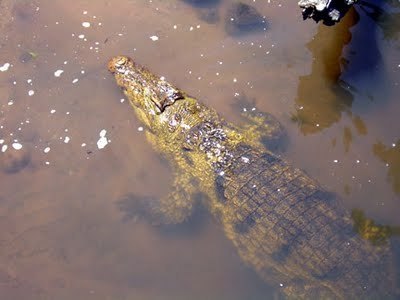


Like this post? Please share by clicking one of the links below.








Like this post? Please share by clicking one of the links below.
Published on August 12, 2011 04:00
August 11, 2011
RomCon Report 3
One thing there's a lot of at reading/writing conferences is swag, or all those free giveaways. RomCon was no different. Everything from business cards to bookmarks to notepads to pens to postcards to excerpt booklets. Plus the slightly more unusual: a tape measure, luggage tag, and a
gizmo
I had to Google to discover it's actual use.
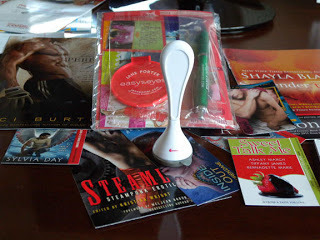
And of course, there are books
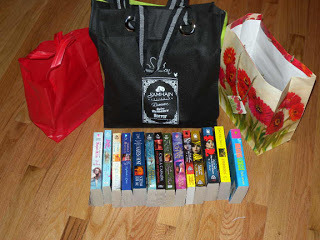
Sunday morning, I opted to go to a discussion group run the by The Book Reading Gals . Although it was designed as a place where readers could discuss their favorite books, authors, genres (and pet peeves), authors were allowed to attend. After all, we probably read a lot more books than we write.
There was discussion as to whether a modern-day man would have any of the skills required in a world where he would be required to hunt his own food and defend himself with the weapons of the day.
Another question was how much accuracy a reader demanded before dismissing a book. Some were willing to accept liberties with details, especially historical ones if they weren't too blatant and if the story worked. And, of course, a lot depends on the reader's knowledge of the times.
Historicals aren't the only places where readers prefer accuracy. One attendee pointed out that a Very Big Name Famous Best Selling Romance Author set a book in Oregon and had the characters pumping their own gas. This is against the law in Oregon, but is probably not something anyone who hasn't tried to fill their own tank at an Oregon gas station would know. (I'm proud to say that I knew this and actually used this bit of information in a scene from my upcoming ROOTED IN DANGER!)
Oh -- did I mention that at romance reader conventions, there are usually at least a few hunks, happy to pose for pictures with readers. (note: only 1 of the guys is cardboard)
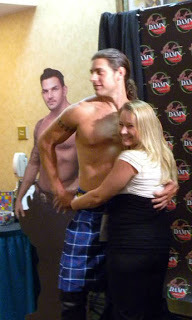
After the Readers Crown Brunch, where they announced this year's winners , there was the RomCon Rumble. Since the closing of Borders meant there couldn't be a book signing, the RomCon organizers came up with a kind of meet the author/speed dating. Each author was given a stack of trading cards featuring one cover, and could also give away any other swag they wanted. Attendees were to visit an author's table to chat, and every three minutes a whistle blew and they'd move on.
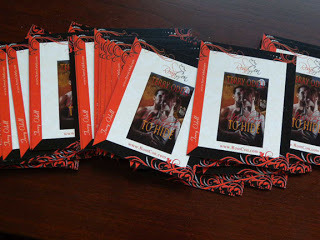
Now, unlike many of the bigger publishing houses, my publishers don't give me boxes of books to hand out. I did have about a dozen books I gave away to people who stopped by my table to chat. One of the ways I decided to select who'd get a book was to write a note on the back of a few of my trading cards. Let me say that there are still two people out there somewhere who could have had a free book had they flipped the card over!
So – anyone want any of my excess swag? Check the Deals and Steals tab.
Like this post? Please share by clicking one of the links below.

And of course, there are books

Sunday morning, I opted to go to a discussion group run the by The Book Reading Gals . Although it was designed as a place where readers could discuss their favorite books, authors, genres (and pet peeves), authors were allowed to attend. After all, we probably read a lot more books than we write.
There was discussion as to whether a modern-day man would have any of the skills required in a world where he would be required to hunt his own food and defend himself with the weapons of the day.
Another question was how much accuracy a reader demanded before dismissing a book. Some were willing to accept liberties with details, especially historical ones if they weren't too blatant and if the story worked. And, of course, a lot depends on the reader's knowledge of the times.
Historicals aren't the only places where readers prefer accuracy. One attendee pointed out that a Very Big Name Famous Best Selling Romance Author set a book in Oregon and had the characters pumping their own gas. This is against the law in Oregon, but is probably not something anyone who hasn't tried to fill their own tank at an Oregon gas station would know. (I'm proud to say that I knew this and actually used this bit of information in a scene from my upcoming ROOTED IN DANGER!)
Oh -- did I mention that at romance reader conventions, there are usually at least a few hunks, happy to pose for pictures with readers. (note: only 1 of the guys is cardboard)

After the Readers Crown Brunch, where they announced this year's winners , there was the RomCon Rumble. Since the closing of Borders meant there couldn't be a book signing, the RomCon organizers came up with a kind of meet the author/speed dating. Each author was given a stack of trading cards featuring one cover, and could also give away any other swag they wanted. Attendees were to visit an author's table to chat, and every three minutes a whistle blew and they'd move on.

Now, unlike many of the bigger publishing houses, my publishers don't give me boxes of books to hand out. I did have about a dozen books I gave away to people who stopped by my table to chat. One of the ways I decided to select who'd get a book was to write a note on the back of a few of my trading cards. Let me say that there are still two people out there somewhere who could have had a free book had they flipped the card over!
So – anyone want any of my excess swag? Check the Deals and Steals tab.
Like this post? Please share by clicking one of the links below.
Published on August 11, 2011 04:00



